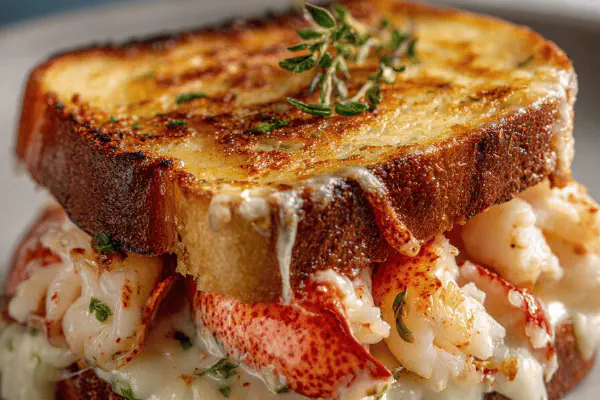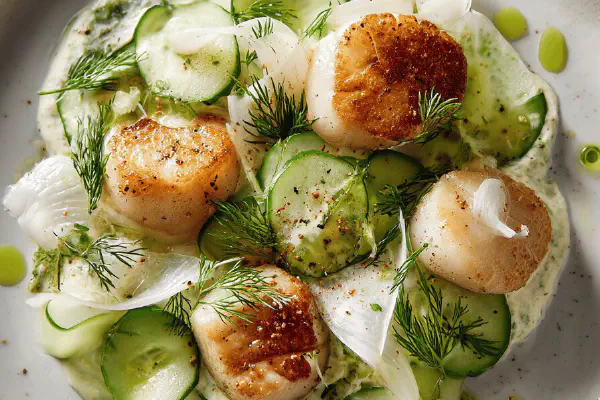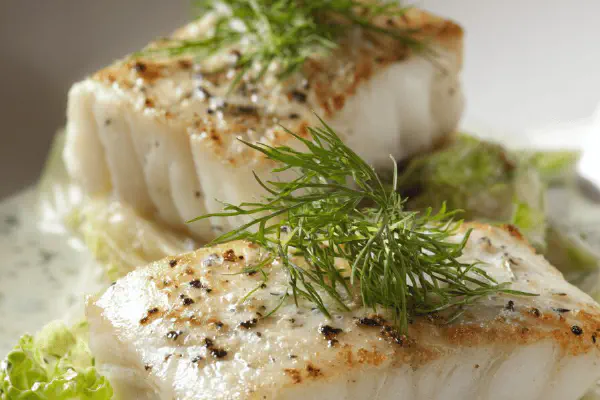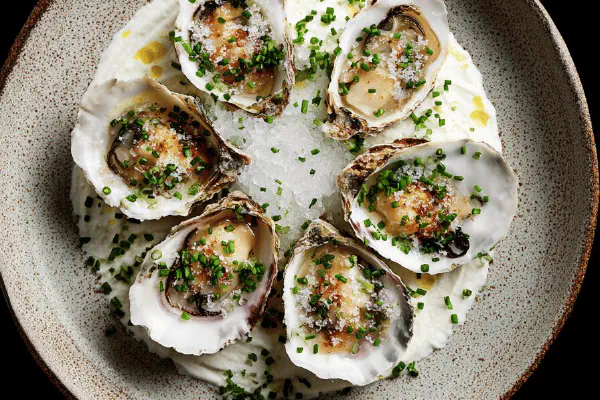Featured Recipe
Shrimp with White Chocolate Cauliflower Purée
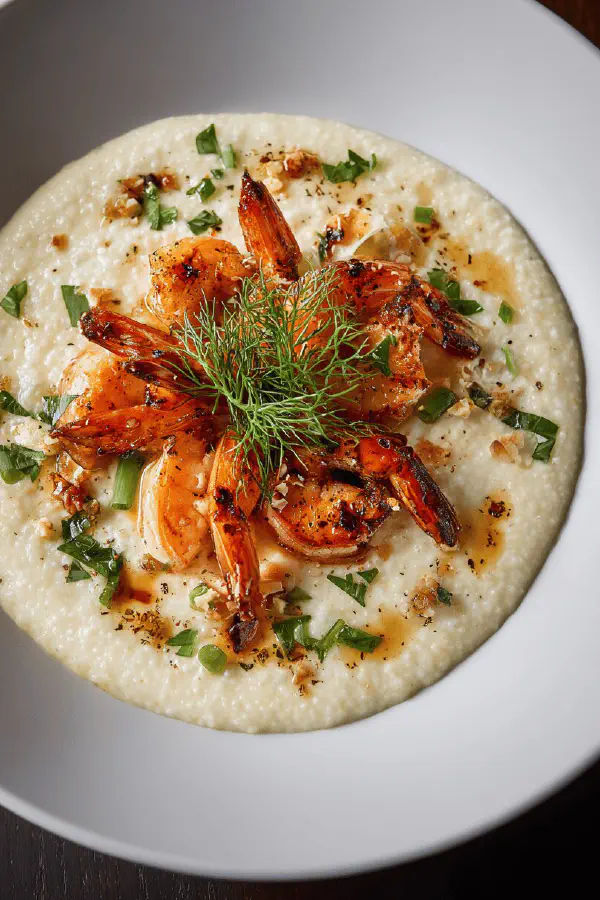
By Kate
"
Gently cooked cauliflower purée paired with succulent shrimp glazed in a white chocolate sauce. Techniques focus on texture and flavor balance, avoiding common pitfalls like watery purée or overcooked shrimp. Swapped cider for dry vermouth for a sharper note, and ginger replaced by lemongrass for freshness. Slightly reduced butter, added a hint of lime zest in purée to brighten. Method reordered for efficiency. Timing guided by sensory cues, not strict clocks.
"
Prep:
25 min
Cook:
35 min
Total:
60 min
Serves:
6 servings
shrimp
cauliflower
white chocolate
French cuisine
seafood
Introduction
Shrimp and white chocolate—sounds odd. But here’s how you make it work. Cauliflower purée acts as subtle canvas, creamy but restrained. Using shallot instead of onion adds gentler bite, balancing sweet notes. Swap ginger for lemongrass for brightness rather than warmth. Dry vermouth replaces cider—it cuts sharper, lifts flavors without overpowering. White chocolate provides sweetness with buttery mouthfeel, but timing is everything—add too soon, sauce breaks; too late, undercooked. Focus on texture, timing, aromas. Shrimp cooks fast, judge by color and curl. Not about clocks; about senses. Keep sauce loose yet glossy, purée fluffy yet not watery.
Ingredients
About the ingredients
Cauliflower must be fresh or well-stored to avoid watery purée. If milk unavailable, unsweetened oat or almond milk work but change flavor slightly. Butter is key for silkiness; don’t skimp. Shallots over onions give cleaner, softer base flavor—onions overpower in light purée. Lemongrass is subtle but aromatic—if unavailable, use a small strip of lemon zest. Dry vermouth replaces cider’s sweetness with herbal sharpness. For white chocolate, pick good quality; avoid candy coating. Shrimp size matters; larger ones absorb sauce better and hold texture. Frozen shrimp must be fully thawed and patted dry; excess water ruins sear and sauce.
Method
Cauliflower Purée
- 1. Pour cauliflower, finely chopped shallot, and milk into a medium saucepan. Bring to simmer over medium heat; bubbles should just break surface. Cover tightly. Simmer gently for 12-18 minutes; cauliflower tender when pierced with fork but not mushy. Drain thoroughly in colander; press with spoon to remove excess liquid--too wet purée splits and is bland.
- 2. Transfer cauliflower mixture to blender or food processor. Add butter and lime zest. Blend until velvety smooth, at least 1 minute, scraping sides to ensure even texture. Season with salt and pepper after blending, not before, to avoid curdling milk.
- 3. Keep warm in covered bowl or low oven. Stir every few minutes to prevent skin from forming. If too thick, whisk in splash of warm milk before serving.
- 4. Heat large nonstick skillet over medium heat. Add 15 ml (1 tbsp) butter. When melted and foaming, add shallot. Stir gently until translucent and soft, about 3 minutes. Add garlic and bruised lemongrass slices. Cook 1-2 minutes until fragrant but not browned. Too hot kills aromatics, turns bitter.
- 5. Pour dry vermouth to deglaze pan. Raise heat to medium-high; reduce liquid by half until it thickens slightly, silky sheen appears and aroma sharp but not boozy.
- 6. Nestle shrimp in sauce in single layer. Cover pan. Shrimp cooks quickly; after 3 minutes shrimp should curl, opaque with slight pink. If shrimp still translucent, give 30-second increments uncovered but watch closely; overcooked shrimp tough and rubbery.
- 7. Remove shrimp with tongs or slotted spatula to warm plate. Discard lemongrass pieces or keep for garnish if desired.
- 8. Return pan to low heat. Add remaining 45 ml (3 tbsp) butter and white chocolate. Stir continuously until chocolate melts fully and sauce reduces to glossy, syrupy texture about 2 minutes. Sauce should coat spoon nicely. Too much heat separates butter and chokes sauce; if happens, add few drops cold water and whisk vigorously to bring back together.
- 9. Taste sauce; add salt and pepper gradually. Sauce must balance sweetness of white chocolate and acidity from vermouth.
- 10. Serve shrimp arranged on cauliflower purée. Spoon white chocolate sauce generously over shrimp—warm but not hot; chocolate flavor more pronounced if sauce not boiling. Garnish with finely chopped fresh herbs like chives or parsley if available.
Shrimp
Technique Tips
Start purée to simmer then cover to avoid evaporation losses and overcooking cauliflower into waterlogged mush. Draining well is critical; excess liquid means thin purée, losing richness—press with spoon or cheesecloth if needed. Blend with butter off heat to prevent butter separating. Season after blending prevents curdling. Cooking shrimp requires medium heat—not too hot, or aromatics burn, sauce turns bitter. Covering softens shrimp quickly but watch color change tightly; translucent to opaque is key. Sauce formed by butter and chocolate reduction needs constant stirring to emulsify; overheating causes breaking. If sauce splits, low temp and whisking can fix. Dress shrimp over purée immediately; sauces congeal fast.
Chef's Notes
- 💡 Start with fresh cauliflower. Wilted? Too much water in purée. Always drain excess. Press it out. Watch your purée; texture matters.
- 💡 Pay attention to shallots. Sauté gently; scorching turns bitter. Careful heat brings sweetness. Add garlic later; avoid burning.
- 💡 Lemongrass is key. Didn’t find it? Use lemon zest—crest a bit of freshness. Skip bitterness. Don’t overdo acidity; balance is essential.
- 💡 When cooking shrimp, watch closely. Translucent to opaque is cue to flip. Overcook? Tough and rubbery. Control heat.
- 💡 Glaze shrimp properly; white chocolate sauce needs low heat. Stir constantly; don’t let it split. Cold water can save a broken sauce.
Kitchen Wisdom
What if my purée is too thin?
Drain longer. Press out water. Consider using cheesecloth.
Can I substitute vermouth?
Yes, dry white wine works. Reduce sweetness elsewhere; too much sugar alters flavors.
Shrimp not cooking evenly?
Single layer in your pan or skillet. Stacking delays heat; watch each piece.
How to store leftovers?
Shrimp can spoil; keep separate from purée. Fridge for a day only. Reheat gently, keep covered.
